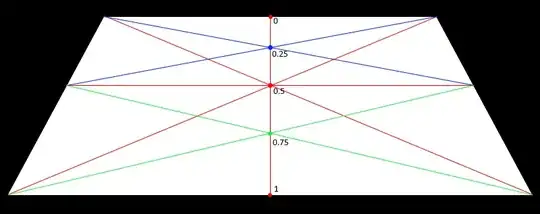TL;DR: See $\eqref{G4}$ below, under "There is a single solution, yielding".
Without loss of generality, we can pick a 3D coordinate system where the eye is at origin $(0, 0, 0)$, we look along the positive $z$ axis, $x$ axis being right, $y$ axis up, and the projective plane is at $z = 1$; and we have a rectangle with vertices at $(-x_r, y_0, z_0)$, $(x_r, y_0, z_0)$, $(x_r, y_1, z_1)$, and $(-x_r, y_1, z_1)$. Perspective projection to the projective plane at $z = 1$ is
$$\left\lbrace \, \begin{aligned}
\chi = x^\prime &= \frac{x}{z} \\
\gamma = y^\prime &= \frac{y}{z} \\
z^\prime &= \frac{z}{z} = 1 \\
\end{aligned} \right.$$
Note, this is not an approximation, this is exact with the above conditions.
The projected coordinates for the four vertices are
$$\left\lbrace \, \begin{aligned}
\chi_{00} &= -\frac{x_r}{z_0} \\
\gamma_{00} &= \frac{y_0}{z_0} \\
\end{aligned} \right., \quad \left\lbrace \, \begin{aligned}
\chi_{01} &= \frac{x_r}{z_0} \\
\gamma_{01} &= \frac{y_0}{z_0} \\
\end{aligned} \right., \quad \left\lbrace \, \begin{aligned}
\chi_{10} &= -\frac{x_r}{z_1} \\
\gamma_{10} &= \frac{y_1}{z_1} \\
\end{aligned} \right., \quad \left\lbrace \, \begin{aligned}
\chi_{11} &= \frac{x_r}{z_1} \\
\gamma_{11} &= \frac{y_1}{z_1} \\
\end{aligned} \right.$$
We can parametrise the surface of the rectangle with $0 \le u \le 1$, $0 \le v \le 1$ using
$$\left\lbrace \, \begin{aligned}
x &= x_r (2 u - 1) \\
y &= y_0 + (y_1 - y_0) v \\
z &= z_0 + (z_1 - z_0) v \\
\end{aligned} \right.$$
The projected coordinates for the parametrised surface are
$$\left\lbrace \, \begin{aligned}
\chi &= \frac{ x_r (2 u - 1) }{ z_0 + (z_1 - z_0) v } \\
\gamma &= \frac{ y_0 + (y_1 - y_0) u }{ z_0 + (z_1 - z_0) v } \\
\end{aligned} \right. \tag{1}\label{G1}$$
and its inverse is
$$\left\lbrace \, \begin{aligned}
u &= \frac{ \chi (y_0 z_1 - y_1 z_0) + \gamma x_r (z_1 - z_0) - x_r*(y_1 - y_0) }{ 2 \bigl ( \gamma x_r (z_1 - z_0) + x_r (y_0 - y_1) \bigr) } \\
v &= \frac{y_0 - \gamma z_0 }{ \gamma (z_1 - z_0) - (y_1 - y_0) } \\
\end{aligned} \right. \tag{2}\label{G2}$$
The last equation is the one we need, except that we also need a way to derive the constants $x_r$, $y_0$, $z_0$, $y_1$, and $z_1$ from the projected coordinates $\chi_{00}$ through $\gamma_{11}$.
However, now that we have the form of $u(\chi, \gamma)$ and $v(\chi, \gamma)$ functions, we can instead use that form with simple constants, and fit those constants to the observed coordinates!
(This is a trick I personally use often with Computer Algebra Systems like wxMaxima, because it is much less work than finding how to map the known constants to $\eqref{G2}$. As long as we don't accidentally omit any coefficients, this works perfectly. So, do compare $\eqref{G2}$ and $\eqref{G3}$ to see they have the same form.)
For simplicity, I will use $x$ (instead of $\chi$) for the projected $x$ coordinate, and $y$ (instead of $\gamma$) for the projected $y$ coordinate, since we no longer care about the actual 3D coordinates. We have
$$\left\lbrace \, \begin{aligned}
u(x, y) &= \frac{U_0 + U_1 x + U_2 y}{y + U_3} \\
v(x, y) &= \frac{V_0 + V_1 y}{y + V_2} \\
\end{aligned} \right. \tag{3}\label{G3}$$
Let's say the four vertices of the isosceles trapezoid are at $(-x_1, y_1)$, $(+x_1, y_1)$, $(+x_2, y_2)$, and $(-x_2, y_2)$. The diagonals cross at $(0, y_0)$, where
$$y_0 = \frac{x_1 y_2 + x_2 y_1}{x_1 + x_2}$$
Now we have seven equations for seven unknowns to solve:
$$\left\lbrace \, \begin{aligned}
u(-x_1, y_1) &= 0 \\
u(+x_1, y_1) &= 1 \\
u(-x_1, y_2) &= 0 \\
u(+x_1, y_2) &= 1 \\
\end{aligned} \right. \quad \text{ and } \quad \left\lbrace \, \begin{aligned}
v(0, y_1) &= 0 \\
v(0, y_0) &= \frac{1}{2} \\
v(0, y_2) &= 1 \\
\end{aligned} \right.$$
There is a single solution, yielding
$$\left\lbrace \, \begin{aligned}
u(x, y) &= \frac{ x (y_2 - y_1) + y (x_2 - x_1) + x_1 y_2 - x_2 y_1 }{2 \bigl( y (x_2 - x_1) + x_1 y_2 - x_2 y_1 \bigr) } \\
v(x,y) &= \frac{ (y - y_1) x_2 }{ y (x_2 - x_1) + x_1 y_2 - x_2 y_1 } \\
\end{aligned} \right. \tag{4}\label{G4}$$
Note that this is not an approximation; this is correct for any rectangle whose projected corners are at $(-x_1, y_1)$, $(+x_1, y_1)$, $(+x_2, y_2)$, and $(-x_2, y_2)$.
Also note that $u(-x_1, y_1) = u(-x_2, y_2) = 0$, $u(0, y) = 1/2$, $u(x_1, y_1) = u(x_2, y_2) = 1$, $v(x, y_1) = 0$, $v(x, y_2) = 1$, and $v(x, y_0) = 1/2$ where $y_0$ is the $y$ coordinate where the diagonals of the projected trapezoid intersect, $y_0 = (x_1 y_2 + x_2 y_1) / (x_1 + x_2)$.
